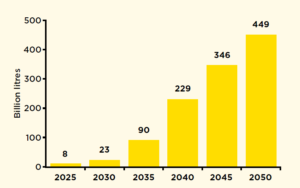Canola, prepare to take off
The 70,000 foot-pounds of thrust needed to lift a fully loaded Boeing 787 Dreamliner could soon come from canola oil.
The International Air Transport Association (IATA), which represents the world’s major airlines, including Air Canada and WestJet, has a goal to reach carbon net zero by 2050. Airlines are looking for sustainable aviation fuel as a way to reduce their carbon footprint. IATA claims that sustainable aviation fuels can reduce CO2 emissions by up to 80 per cent.
The potential market is huge, but will build slowly. IATA forecasts use of eight billion litres by 2025, which represents less than two per cent of jet fuel demand, and 449 billion litres by 2050. Current global demand for jet fuel from petroleum sources is just above that 449 billion mark.
To put that in perspective, Canada’s annual demand for diesel fuel is 20 billion litres per year. Global demand for diesel is over 1,600 billion litres per year. The aviation fuel market, though smaller than the diesel market, is still very large. (See the box for a more detailed market comparison.)
Aviation fuel and diesel fuel are similar. Aviation fuel could actually be used in diesel tractors, but with different standards and more challenging specifications for aviation fuel, jets cannot use diesel fuel. Aviation fuel has lower density, weighing 775-840 kg per cubic metre at 15°C compared to diesel at 840-850. This lower density means lower energy per volume, but aviation fuel needs lower density so it does not congeal in very cold temperatures at 35,000 feet.
“For farmers, renewable diesel and sustainable aviation fuel are tremendous opportunities to diversify markets. These will be a significant market over time.”
— David Schick
Canola and other feedstocks
Sustainable aviation fuel is made from sources other than petroleum. IATA lists potential feedstock as “waste fats, oils and greases, municipal solid waste, agricultural and forestry residues, wet wastes, as well as non-food crops cultivated on marginal land.”
When asked to confirm whether feedstock will include crop-based oils, Nicolas Jammes, IATA’s assistant director of environment communications, says “IATA remains agnostic in our feedstock position” as long as the feedstock contributes to the airline industry meeting its net zero target.
David Schick, the Canadian Fuels Association vice president for Western Canada and innovation and regulatory affairs, says canola oil works well for sustainable aviation fuel. So does tallow. “These are dense carbon molecules,” he says.
The disadvantage for canola oil, Schick says, is cost. “Airlines are conscious of fuel prices. They want to meet sustainability goals but need to keep fuel costs low,” he says. He adds that biofuels could also use canola oil that doesn’t meet food specifications. “Refineries don’t care.”
In time, sources other than first-use vegetable oils will likely account for most of the supply. Schick says any biomass that has carbon can be converted into a liquid fuel. This can include sawdust and chaff. IATA says sustainable aviation fuels can also be produced through a process that captures carbon from the air. However, none of these alternatives is commercially available at scale. Canola oil and other plant-based oils are high quality, energy rich and available in sufficient quantity to kick off the process.
Canada does not currently have any commercial production of sustainable aviation fuel, although “people are actively working on it,” Schick says. New renewable diesel facilities announced or under construction all have the potential to produce aviation fuel.
We know that Canadian canola will have access to the U.S. sustainable aviation fuels market. The U.S. Environmental Protection Agency (EPA) announced a year ago that sustainable aviation fuel and renewable diesel made from canola oil will qualify as “advanced biofuels” under the U.S. Renewable Fuel Standard program.
“It’s a gratifying outcome after many years of engagement and outreach with the EPA, in collaboration with the Canadian Oilseed Processors Association (COPA), the U.S. Canola Association and several other organizations, that canola is now recognized as an advanced biofuel in the United States,” says Chris Davison, president and CEO of the Canola Council of Canada.
“For farmers, renewable diesel and sustainable aviation fuel are tremendous opportunities to diversify markets,” Schick says. “These will be a significant market over time.”
Global fuel demand
The world extracted 99.92 million barrels of oil per day (mb/d) in 2022, according to data from the International Energy Agency (IEA). The United States is the biggest oil producing nation in the world, accounting for 17.85 mb/d, on average, in 2022. Russia is second and Saudi Arabia is third. Canada is fourth, producing 5.76 mb/d in 2022.
Global demand basically matches production – it all gets used. The best year for an accurate reflection of petroleum demand is 2019, the last full year before the pandemic slow down. In 2019, petroleum demand included 28.3 mb/d of diesel fuel, 26.7 mb/d of gasoline and 8.0 mb/d of jet fuel. IAE predicts that global demand for gasoline and diesel will start to drop through this decade, while demand for jet fuel will continue to increase.
A barrel is 159 litres, so 8.0 mb/d of jet fuel is equivalent to 464.3 billion litres per year.
Currently, sustainable aviation fuel supplies far less than one per cent of global jet fuel demand. The International Air Transport Association (IATA) forecasts sustainable aviation fuel to reach eight billion litres by 2025 (still less than two per cent of total fuel use) and 449 billion litres by 2050 (which could be most of the total fuel use.)
Sustainable aviation fuel needed to meet net zero

The International Air Transport Association (IATA), which represents the world’s major airlines, has a goal to reach net zero carbon emissions by 2050. This graph shows the expected global increase in sustainable aviation fuel required to meet net zero.





